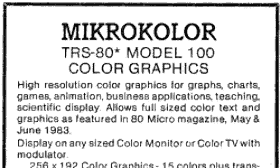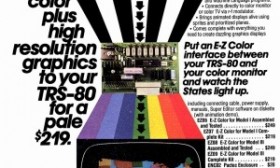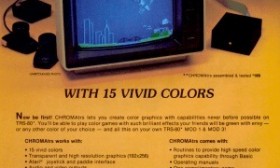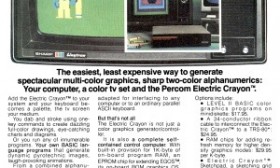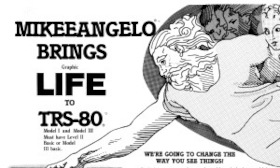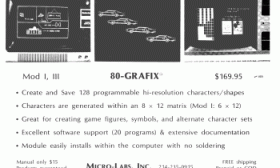Articles in the "Graphics" Category
The Mikrokolor was a color graphics interface for the TRS-80 Model 100 that was sold by Andreasen’s Electronics Research & Development, Inc. The Mikrokolor hardware was designed by Paul Andreasen, the digital interface and graphics routines created by James Cole, and the software written by Andrew Baird. Andreasen’s Electronics Research & Development also sold versions of the Mikrokolor for the Model I, Model III, Model 4, and Model 12 and also the S-100 bus and the Apple II. There was also a $54.00 VHF modulator for the Mikrokolor that operated on channels 7 to 10.
The Mikrokolor fit into much the same category as the later Disk/Video Interface sold by Radio Shack, allowing a Model 100 to be used with a separate monitor. Unlike the Disk/Video Interface, which was black and white only, the Mikrokolor displayed in color.
(Read more...)
Micromint sold several products for the TRS-80 that were based on designs that Steve Ciarcia had presented in his Ciarcia’s Circuit Cellar column in Byte magazine. The Micromint E-Z Color was a color graphics interface for the TRS-80 Model I and Model III that was based on his August 1982 column. In addition to the TRS-80 version, there were also versions of the E-Z Color sold for the S-100 bus and the Apple II.
The TRS-80 version was available in two configurations:
(Read more...)
Probably the most popular of the TRS-80 Model I and III color add-ons was the CHROMAtrs, introduced by South Shore Computer Concepts starting in 1982. It was available in several configurations:
- a kit without case or power supply cost $99.00
- a kit with case and power supply cost $129.00
- a fully-assembled and tested unit cost $169.00
Each CHROMAtrs unit supported both the Model I or Model III and would work with either computer using the proper cable. The Model III cable would also work with the Lobo MAX-80 with a few minor modifications.
(Read more...)
Back in the late 1970’s, the Apple II and the TRS-80 Model I were fierce competitors for computer sales. One advantage the Apple II had over the Model I was the ability to display color graphics. One of the first Model I productsto address this deficiency was the Percom Electric Crayon. Percom introduced the Electric Crayon in December 1979 for a base price of $249.00. It was featured on the cover of the January 1981 issue of 80 Microcomputing.
The Electric Crayon was a small (12 inch wide by 9 inch deep) box which output a composite video signal that could drive either a monitor or a television set. It connected directly to the TRS-80 printer port and was controlled using EGOS, a ROM-based operating system. EGOS was directly programmed using single character commands. Virtually unique among TRS-80 color add-ons, the Electric Crayon did not use the TMS9918 graphics chip and did not support sprites.
(Read more...)
The Mikeegraphic Graphics System was a high-resolution graphics add-on for the TRS-80 Model I and Model III. It was sold by Mikee Electronics Corporation for $340. Originally known as the Mikeeangelo when it was introduced in late 1981, the name was changed to Mikeegraphic just a few months later, presumably to avoid confusion with another product.
Unlike the 80-GRAFIX, which provided high-resolution using a programmable character generator, the Mikeegraphic used a true bitmapped graphics screen. The high-resolution screen was mapped in its entirety at the top of the TRS-80 memory.
(Read more...)
Many people considered the lack of high-resolution graphics to be the biggest deficiency of the TRS-80 Model I. The maximum resolution of the Model I was 128 by 48 by using block graphics. Many games made good use of that resolution, but it was still low compared to other computers.
The 80-GRAFIX was one of several high-resolution add-ons available for the Model I. Designed by Ted Carter, it was originally sold by Programma International for $149. The 80-GRAFIX fit entirely within the Model I case and required only minimal soldering.
(Read more...)
